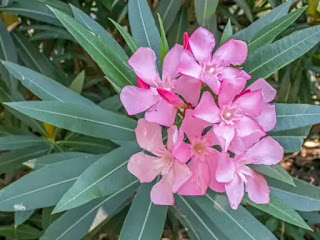Your Mandevilla plants that were thriving in the garden, bringing joy with all their fantastic blooms are suddenly getting yellow leaves when brought indoors. After some weeks, your beautiful Mandevillas or your Oleander look pathetic and seem to die. What happened? Tiny little critters, called spider mites are nesting and multiplying, and you detect even a miniature white net between the twigs of your plants.
Spider mites are brought into the house via your shoes, and clothing, nestled in between animal fur, and, most importantly, from other infected plants or via the indoor planting soil, flowers, and vegetables brought into the house and even through window screens as they are so tiny.
Spider mites thrive in warm, dry conditions and can become a major problem during the winter when your dry house becomes the perfect breeding ground for them. Spider mites multiply very quickly and, in the right conditions, can double their population every couple of weeks.
.
Humidity Too Low
When humidity is low, spider mites (Tetranychidae) can become a problem. The small eight-legged creatures are difficult to see with the naked eye and are mainly found on the underside of leaves near the leaf veins. The infested leaves are initially delicately speckled before they first turn silvery, then gray-brown, and finally, fall off. Another identifying feature is webbing which can be found in leaf axils and on leaf margins.
- As a preventive measure, plants that overwinter in a dry, slightly cool place should be sprayed with water from time to time.
- The first thing you should do is quarantine the infested plant and inspect all surrounding houseplants for mites.
- In case of infestation, shower the whole plant with lukewarm water. Wrap it in a plastic bag or a translucent garbage bag for three days, high humidity will kill the spider mites.
- A good prevention is to spray your house plants with tea tree oil or Neem oil.
- Canola oil-based pesticides smother the spider mites; especially the undersides of leaves should be treated
Here is a spider mite insecticide soap recipe:
1 small teaspoon of mild liquid soap
1 liter of tepid water
***** NEVER USE ANY CHEMICAL PESTICIDES *****
.
Mandevilla Plants Overwintering
During the over-wintering in the house, the plant should be watered very sparingly and not fertilized at all. However, place it close to a sunny window - but in a cool room and away from heating outlets. Only in spring, around April, some diluted liquid fertilizer can be added to the watering and the room temperature should be slowly increased. Spraying the leaves frequently with a water bottle keeps them moist - which spider mites don’t like. From late May on, when no frosts are expected, it can move outside again. Here it should first be accustomed to the sun again for a few days in partial shade.
Disinfect the Indoor Potting Soil
To ensure that your indoor plant soil is clear of bacteria and illnesses, disinfect it with hydrogen peroxide. To do this, just sprinkle some hydrogen peroxide in your organic potting mix. You also can sterilize potting soil in your oven. Place it in an oven-safe pan, cover it with foil, and bake it at 180 to 200 degrees Fahrenheit for 30 minutes.
Oleander Indoors
Years ago, I had every winter an aphid problem with Oleanders in large pots that I brought into my solarium. I carried the whole pot into my shower and sprayed it with tea tree oil, but also pruned it a bit.
Oleander plants (Nerium oleander) easily become victims of pests. In particular, some species of lice, as well as spider mites eat the oleander. However, since they significantly weaken the plants, it is essential to fight them. Healthy plants are more resistant and are not attacked as quickly as weaker ones. So often an infestation of pests indicates a care error such as the wrong location. Too much nitrogen can also be the cause, as it makes the tissue softer and more susceptible.
Aphids (Aphidoidea) are much easier to detect than spider mites because of their size of a few millimeters. On the oleander, they only sit on fresh shoots and inflorescences, where they pierce the plant to get at its sweet sap. The first thing you usually notice is the white sheaths that are formed when aphids molt and stick to the plant.
https://getbusygardening.com/control-spider-mites/
.
<><><><><>
.








